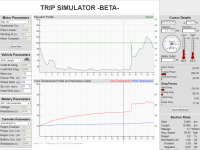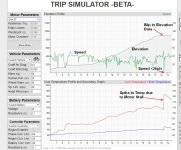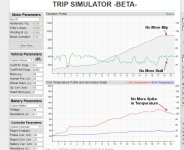drbenjamin
10 mW
All
trying to decide between a Mac 12T and a BBSHD for my commuter setup. I tried out the Grin trip simulator on their site (which is very cool) and got a surprising result - see below. A long part of my ride is along a river, and I don't expect to use any power there. I set the speed limit to reflect that - along the straight part the watts used show 0, however the core temperature (red line) keeps rising. It makes the temp spike when I hit a steep hill more alarming since the motor is already 35 deg. Is that how geared hubs behave? Do they heat up from pedaling even w/o power?

Thanks!
trying to decide between a Mac 12T and a BBSHD for my commuter setup. I tried out the Grin trip simulator on their site (which is very cool) and got a surprising result - see below. A long part of my ride is along a river, and I don't expect to use any power there. I set the speed limit to reflect that - along the straight part the watts used show 0, however the core temperature (red line) keeps rising. It makes the temp spike when I hit a steep hill more alarming since the motor is already 35 deg. Is that how geared hubs behave? Do they heat up from pedaling even w/o power?

Thanks!




